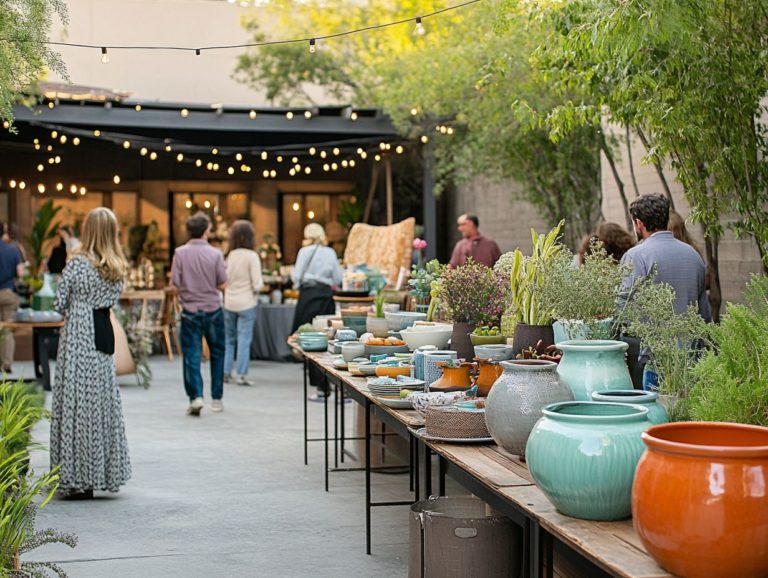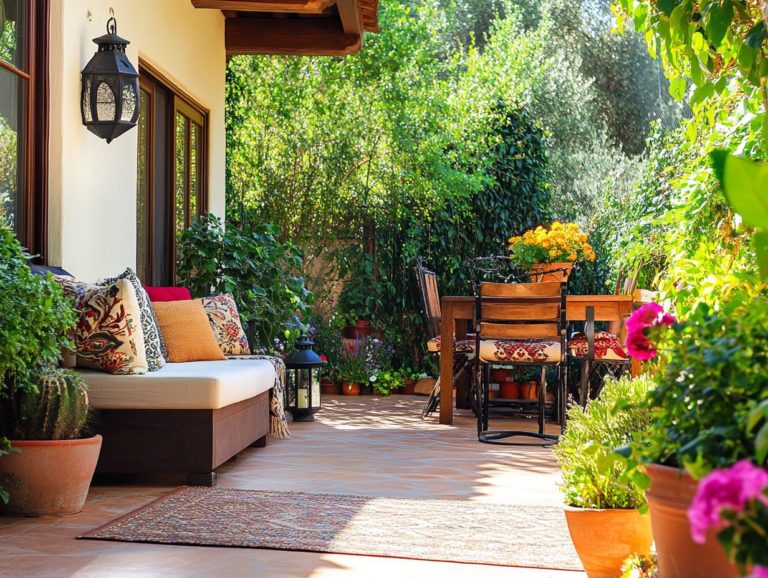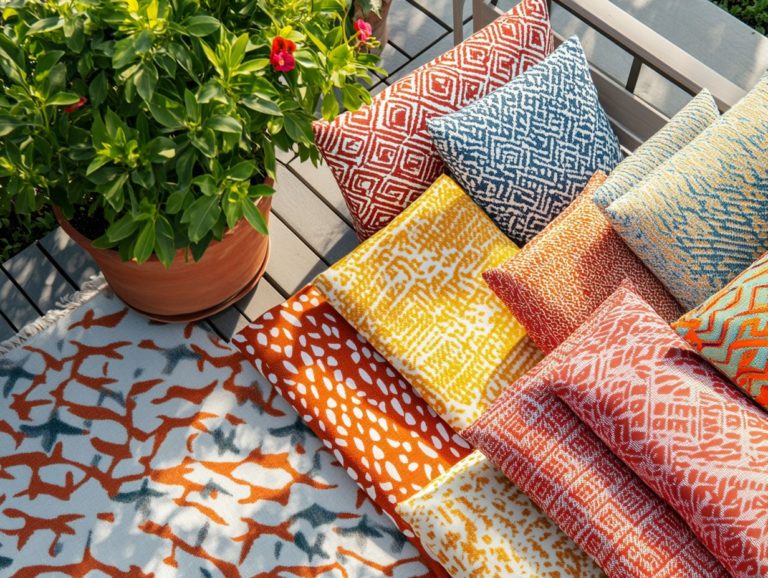“Top Trends in Outdoor Decor for Eco-Conscious Homeowners”
Transform your outdoor space into a stunning, eco-friendly retreat! Creating an outdoor area that looks beautiful and is good for the environment has never been more essential.
As an eco-conscious homeowner, you want to combine style and sustainability. Numerous innovative trends are available to you. From selecting sustainable materials for your furniture to incorporating vertical gardens, you’ll discover compelling trends in outdoor d cor that elevate your space and nurture the planet.
Explore how to turn your outdoor areas into serene, eco-friendly retreats that reflect your values and aesthetic sensibilities.
Contents
- Key Takeaways:
- 1. Sustainable Materials for Furniture and Decor
- 2. Vertical Gardens and Living Walls
- 3. Solar-Powered Lighting
- 4. Water Conservation Features
- 5. Use of Recycled and Upcycled Materials
- 6. Multifunctional Outdoor Spaces
- 7. Incorporation of Natural Elements
- 8. Minimalist and Functional Designs
- 9. Embracing Native Plants
- 10. DIY and Handmade Decor
- 11. Smart Irrigation Systems
- 12. Outdoor Kitchens and Dining Areas
- 13. Design That Connects Your Space to Nature
- 14. Sustainable Pest Control Methods
- 15. Eco-Friendly Outdoor Entertainment Options
- How Can Homeowners Incorporate These Trends into Their Outdoor Spaces?
- Frequently Asked Questions
- What are the top trends in outdoor decor for eco-conscious homeowners?
- How can I use sustainable materials in my outdoor decor?
- Why is incorporating native plants important for eco-conscious homeowners?
- What are the benefits of using solar-powered lighting in my outdoor decor?
- How can I create a natural water feature in my outdoor decor?
- Why should I implement a rainwater harvesting system in my outdoor decor?
Key Takeaways:

- Use sustainable materials to cut your environmental impact.
- Add greenery with vertical gardens to boost air quality.
- Switch to solar lighting for energy savings and a cozy atmosphere.
1. Sustainable Materials for Furniture and Decor
Choosing sustainable materials is important this autumn. Embracing sustainable materials for your furniture and decor enhances both aesthetics and environmental consciousness. Incorporating elements like teak and bamboo offers durability and low maintenance, while building materials such as recycled plastics and natural stone help create personalized spaces that feel luxurious.
Urban Grace Interiors effectively highlights these materials in their designs, showing that style can intertwine with responsibility. For example, reclaimed wood tables add character and warmth while complementing your seasonal decor.
This autumn, popular eco-friendly trends include integrating organic textiles and natural fibers into your home textiles, enhancing comfort while minimizing your impact on the environment.
Furniture made from recycled materials, like chairs made from repurposed metal, serves as striking statements in any room, aligning with your desire for a more sustainable lifestyle.
2. Vertical Gardens and Living Walls
Vertical gardens and living walls provide a sophisticated solution for homeowners looking to elevate outdoor spaces while embracing environmental sustainability. They enhance aesthetics and improve air quality while fostering biodiversity, or the variety of plant and animal life.
Using native plants is particularly beneficial; they require less water and maintenance while supporting local wildlife. By choosing these options, you can significantly lower your impact on the environment.
Living walls also excel in energy efficiency, offering insulation that reduces heating and cooling costs in your home. Beyond their practical benefits, these lush installations transform ordinary spaces into stunning visual masterpieces, creating inviting atmospheres that enhance your overall well-being and relaxation.
3. Solar-Powered Lighting
Solar-powered lighting presents an eco-friendly solution for homeowners seeking to illuminate outdoor spaces sustainably. This energy-efficient option lowers electricity bills and enhances the ambiance and safety of your environment.
Imagine draping sleek LED string lights around your patio or placing elegant lanterns to create the perfect outdoor dining experience. With a wide variety of choices, crafting the desired atmosphere becomes effortless.
These installations are remarkably easy to set up often requiring no hardwiring allowing seamless integration into your outdoor kitchen. Strategic placement elevates cooking zones and dining areas, ensuring every moment outdoors is well-lit and inviting.
By combining solar technology with LED lights, you enjoy long-lasting illumination that consumes minimal electricity, paving the way for a truly sustainable approach to outdoor lighting and reducing your carbon footprint.
4. Water Conservation Features
Incorporating water conservation features into your outdoor landscape is essential if you prioritize sustainable landscaping practices. By using smart irrigation systems, you can optimize water usage and cultivate a lush, eco-friendly environment.
Embracing innovative techniques like rainwater harvesting allows you to capture and utilize natural precipitation, effectively reducing your dependence on municipal water sources. Drip irrigation systems deliver water directly to your plant roots, ensuring minimal waste and promoting healthy growth.
Selecting drought-resistant plants enhances your landscape’s environmental resilience and adds unique visual appeal. These thoughtful features create a serene, wellness-oriented space that blends aesthetics with sustainability, transforming your garden into a tranquil retreat that positively contributes to the ecosystem.
5. Use of Recycled and Upcycled Materials
The use of recycled and upcycled materials is a transformative trend in outdoor design. This approach allows you to craft stunning, eco-friendly spaces that showcase your commitment to sustainability and minimize waste.
This innovative approach opens up possibilities, like using reclaimed wood to create unique outdoor furniture or incorporating bricks that have been reused to build captivating outdoor fireplaces. These choices reflect a genuine dedication to environmental preservation.
For example, old pallets can be creatively repurposed into rustic benches, offering functionality and a charming touch to your gardens or patios.
By choosing recycled materials, you divert waste from landfills and ignite your creativity, inviting you to explore fresh designs and styles in outdoor decor that embody your personality while championing ecological mindfulness.
6. Multifunctional Outdoor Spaces
Designing multi-functional outdoor spaces is essential to maximize usability while creating luxurious areas for relaxation and entertainment. Using modular furniture and outdoor kitchens can elevate your outdoor experience.
Incorporating elements like outdoor fireplaces and cozy seating areas allows these spaces to serve multiple purposes throughout the year. Imagine hosting a summer barbecue, where family and friends gather around the grill, then transitioning to an intimate evening gathering by the fire as temperatures drop.
The adaptability of modular furniture enables easy rearranging for various occasions, whether it s a lively celebration or a peaceful night under the stars. This versatility enhances the look of your outdoor space and ensures you use every square foot to its fullest potential.
7. Incorporation of Natural Elements
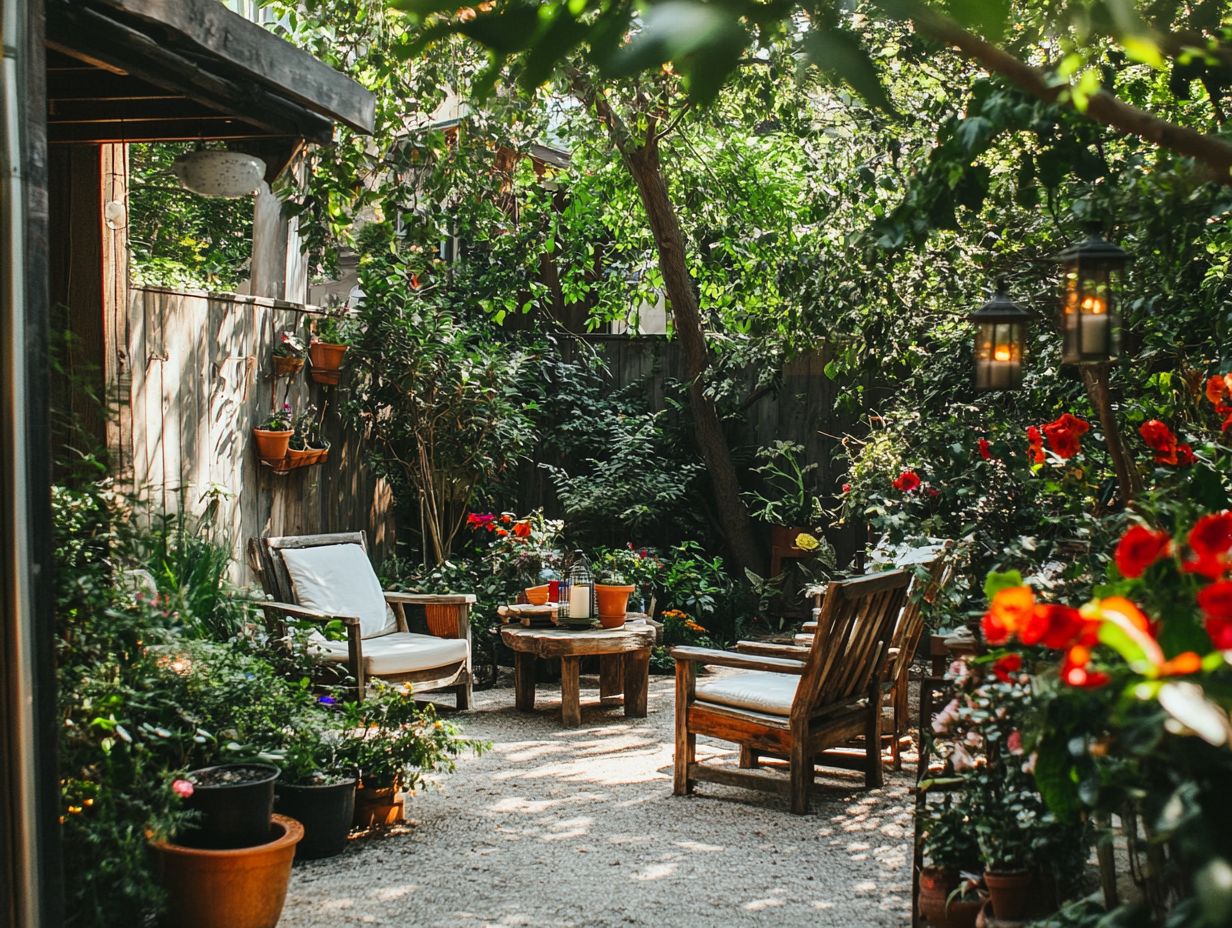
Incorporating natural elements into your outdoor design elevates aesthetics and promotes wellness, crafting a cozy atmosphere that invites you to relax and rejuvenate in your garden.
Using materials like stone, wood, and a variety of plant life plays a crucial role in this transformation. Picture stone pathways adding rustic charm while guiding you through your outdoor spaces, harmonizing perfectly with lush greenery.
Wood, in the form of furniture or decking, infuses warmth and organic texture, fostering a connection with nature. Incorporating diverse plants beautifies the landscape and enhances air quality, creating a serene atmosphere.
Together, these elements embody eco-friendly design principles and create a peaceful retreat that nurtures your spirit.
8. Minimalist and Functional Designs
Minimalist and functional designs are becoming increasingly popular among homeowners, highlighting streamlined furnishings that enhance the aesthetic appeal of outdoor spaces while ensuring practicality and sustainability.
This design philosophy invites you to embrace bold colors and simple lines, creating a cohesive and inviting atmosphere. By choosing a select few dynamic hues, you can make powerful statements that capture attention without overwhelming the senses.
Minimalism is all about functionality. Designers often use furniture that serves more than one purpose, promoting efficient use of space. These designs align seamlessly with eco-friendly practices, prioritizing sustainable materials and minimizing unnecessary consumption.
Imagine enjoying beautifully designed outdoor areas that are not only beautiful but also environmentally responsible!
9. Embracing Native Plants
Embracing native plants in your landscaping is essential for crafting sustainable and environmentally conscious outdoor spaces that require less maintenance and support local ecosystems.
Choose plants that thrive in your area to significantly reduce the water, fertilizers, and pesticides needed. This allows you to enjoy a lush garden without the high upkeep of traditional landscaping. These native species effortlessly integrate into the landscape, providing essential habitats for local wildlife, including birds and pollinators.
Take, for instance, wildflowers like Black-eyed Susans and native grasses such as Big Bluestem. These fit into various design styles, from modern minimalist to rustic gardens, enhancing the beauty and biodiversity of your outdoor spaces.
10. DIY and Handmade Decor
DIY and handmade d cor are popular choices for homeowners like you who desire eco-friendly options that add a personal flair to outdoor spaces while expressing creativity and reducing environmental impact.
As the trend toward sustainable living gains momentum, these projects enable you to infuse your unique style into your home while championing the use of recycled materials and local resources.
From crafting planters out of reclaimed wood to designing whimsical wind chimes from discarded items, you can create personalized pieces that reflect your personality and promote ecological mindfulness.
These thoughtful additions can transform even the simplest gardens or patios into inviting retreats, enhancing the ambiance and making your outdoor spaces feel warm and truly lived-in.
11. Smart Irrigation Systems
Smart irrigation systems change how you save water in your garden. With automated solutions at your fingertips, you can optimize water usage and embrace sustainable gardening practices effortlessly.
By integrating advanced technology like moisture sensors and programmable timers, these systems adeptly respond to the unique needs of your plants and soil conditions. Moisture sensors monitor ground moisture levels, ensuring watering only happens when truly necessary no more watering for the sake of it, which means less water wasted.
Timers elevate efficiency by scheduling irrigation based on weather forecasts or real-time data, allowing you to create personalized watering routines.
This not only helps you maintain a vibrant and healthy landscape but also significantly cuts down on water consumption. It’s a savvy choice for those who are environmentally conscious and want to make a positive impact.
12. Outdoor Kitchens and Dining Areas
Outdoor kitchens and dining areas are must-have features for homeowners who want to blend cooking and entertaining into multi-functional spaces that elevate the pleasure of outdoor living.
These vibrant environments allow you to whip up delicious meals in nature and set the stage for unforgettable gatherings with family and friends. Create inviting atmospheres with energy-efficient lighting that make these spaces usable well into the evening!
Add fire features like outdoor fireplaces or fire pits for warmth and a stunning focal point. These features encourage social interactions and foster relaxation, making your outdoor kitchen a perfect retreat for culinary creativity and lasting memories.
13. Design That Connects Your Space to Nature
Biophilic design creates a seamless connection between nature and your living space, enhancing your well-being.
Integrating elements like abundant natural light brings an uplifting ambiance that boosts your mood and productivity. Adding greenery through strategically placed plants beautifies your space and purifies the air, reducing stress and promoting relaxation.
Using organic materials like wood and stone invites warmth into your home. This thoughtful interplay between indoor spaces and the natural world results in environments that look stunning and encourage a healthier lifestyle.
14. Sustainable Pest Control Methods
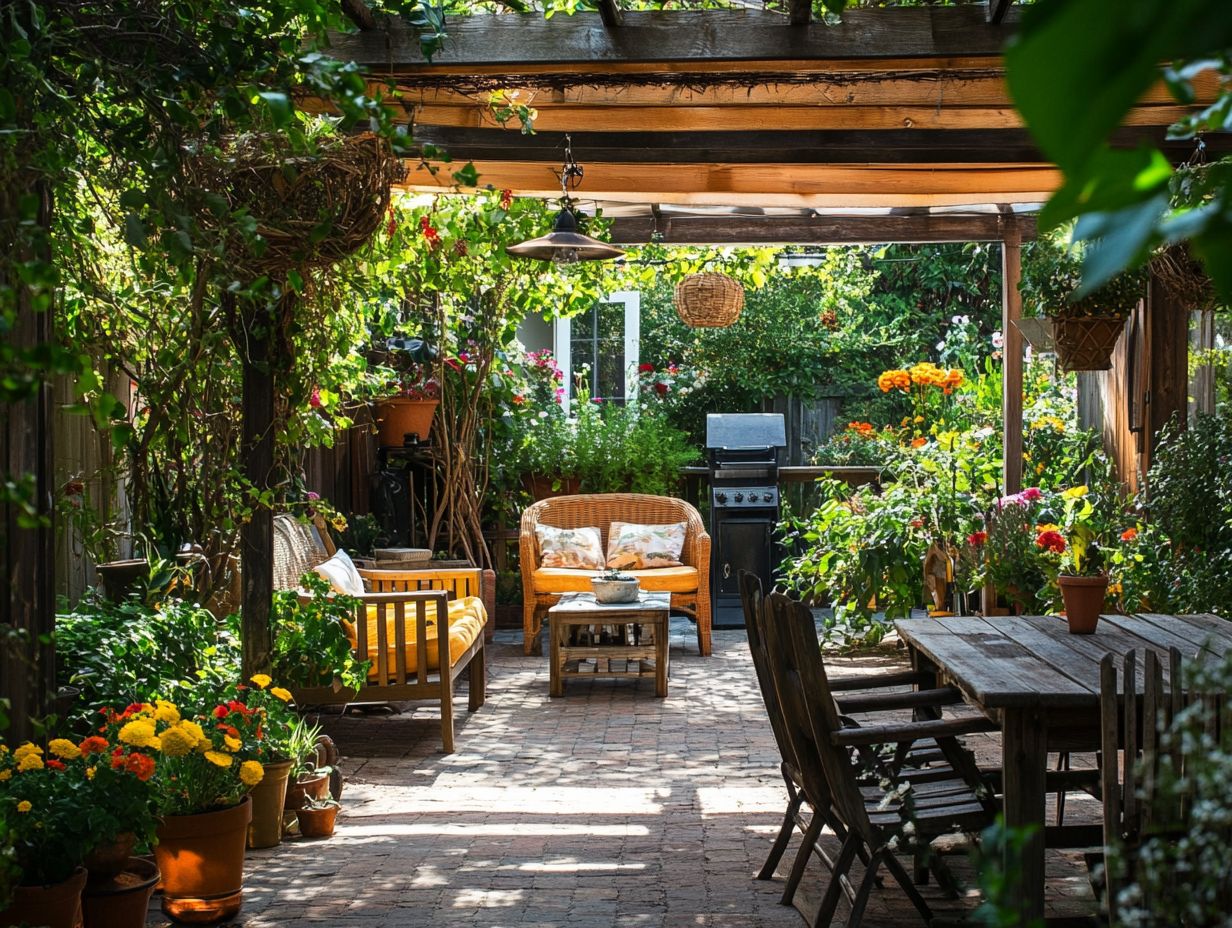
Implementing sustainable pest control methods is essential for homeowners seeking eco-friendly solutions. Protect your garden and promote a healthy ecosystem without harmful chemicals.
Embrace techniques like companion planting to create a harmonious garden. For instance, planting marigolds with vegetables effectively repels aphids and nematodes.
Consider using natural repellents made from essential oils or garlic as effective barriers against unwanted insects. Incorporating native plants enhances pest resistance and boosts biodiversity.
- Boost biodiversity
- Provide habitats for beneficial insects
- Support the environment
15. Eco-Friendly Outdoor Entertainment Options
Create eco-friendly outdoor entertainment options to enjoy your space responsibly. Incorporate elements like fire features and outdoor fireplaces for warmth and ambiance.
These alternatives encourage an environmentally conscious lifestyle and foster inviting atmospheres for gatherings. Host outdoor movie nights under the stars, where guests unwind on solar-powered blankets, or share stories around a fire pit, enjoying toasted marshmallows and laughter!
This blend of relaxation and entertainment allows social interactions to flourish while reducing your carbon footprint. Embrace these ideas to elevate your enjoyment and cultivate a stronger sense of community and environmental stewardship.
Start planning your eco-friendly outdoor space today!
How Can Homeowners Incorporate These Trends into Their Outdoor Spaces?
You can seamlessly incorporate eco-friendly trends into your outdoor space by understanding the essential principles of sustainable design. This means creating spaces that are environmentally responsible and resource-efficient. Select the right materials and embrace innovative technologies that enhance both functionality and aesthetics.
To begin, assess your available space. Consider factors like sunlight exposure, wind patterns, and soil quality. These elements are crucial for selecting the best plants and materials. Integrating features like rain gardens can effectively manage water runoff while enhancing biodiversity. You can also explore energy-efficient lighting options and invest in comfortable, sustainably sourced furniture that complements your overall design.
Most importantly, ensure all elements work cohesively to create an inviting environment. By personalizing your layout to reflect your unique tastes and lifestyle, you can seamlessly blend eco-friendly features into your surroundings, crafting a harmonious outdoor retreat.
What Are the Benefits of Having an Eco-Friendly Outdoor Space?
Creating an eco-friendly outdoor space offers numerous benefits that extend beyond aesthetics. It enhances your environmental awareness, reduces maintenance costs, and elevates your quality of life a truly worthwhile investment for any homeowner!
Integrating native plants into your landscape promotes biodiversity and supports local ecosystems while inviting pollinators essential for food production. You can also enjoy significant cost savings through energy-efficient landscaping solutions. For example, strategically placed trees provide natural shade, helping to lower your cooling expenses during warm months.
Spending time in a nature-inspired environment has been shown to improve mental health by lowering stress levels, boosting your mood, and enhancing overall well-being. These eco-friendly spaces not only elevate the aesthetic appeal of your property but also contribute positively to your life and the planet!
How Can These Trends Benefit the Environment?
Embracing eco-friendly trends in outdoor design can significantly benefit the environment. By promoting sustainable landscaping practices, you ll reduce carbon footprints and enhance biodiversity within local ecosystems.
One standout approach is the increasing focus on utilizing native plants. This shift transforms landscapes into vibrant ecosystems that require less water and maintenance, while supporting local wildlife. Research shows that gardens filled with native species can significantly boost local pollinator populations, with studies indicating a remarkable 50% increase in bee diversity!
Implementing smart irrigation systems is another smart move. These tech-driven solutions adjust watering based on weather conditions, enhancing efficiency and reducing water waste by up to 50%. This results in healthier soil and plants. Choosing sustainable materials is also important. Using recycled or locally sourced products can cut greenhouse gas emissions by up to 30%.
Together, these interconnected practices create visually stunning spaces while contributing to a more resilient and balanced environment!
What Are Some Other Ways to Make Outdoor Spaces More Sustainable?
Countless ways exist to enhance the sustainability of your outdoor spaces. This includes choosing eco-friendly landscaping options and incorporating wellness areas designed for relaxation and mental clarity.
One effective practice to consider is rainwater collection. By repurposing this water for irrigation, you conserve valuable resources while nurturing your plants. Creating meditation gardens offers you a tranquil environment for introspection and promotes biodiversity through the use of native plantings.
Integrating energy-efficient lighting improves safety and ambiance without compromising ecological integrity. By weaving these sustainable elements into your outdoor designs, you cultivate spaces that are environmentally friendly and enrich your overall outdoor experience.
This fosters a deeper connection with nature and significantly enhances your well-being. Start your eco-friendly journey today!
What Are Some Common Mistakes to Avoid When Designing an Eco-Friendly Outdoor Space?
When designing your eco-friendly outdoor space, it’s easy to stumble into common mistakes that can hinder your sustainability goals, like inadequate planning and selecting materials ill-suited for your climate.
Failing to consider the unique local ecosystems can lead to poor plant choices, resulting in greenery that struggles to thrive. This disruption can affect the natural balance.
Overlooking maintenance requirements can lead to higher water usage and resource waste over time. This can mean increased costs and a less sustainable outdoor space.
To steer clear of these pitfalls, it s essential to look up native plants that grow well in your area. Establish a realistic maintenance plan tailored to the materials you choose.
By embracing sustainable practices and focusing on the long-term health of your outdoor space, you can create an area that beautifully harmonizes with nature. Imagine a garden that not only looks great but also helps the planet!
Frequently Asked Questions
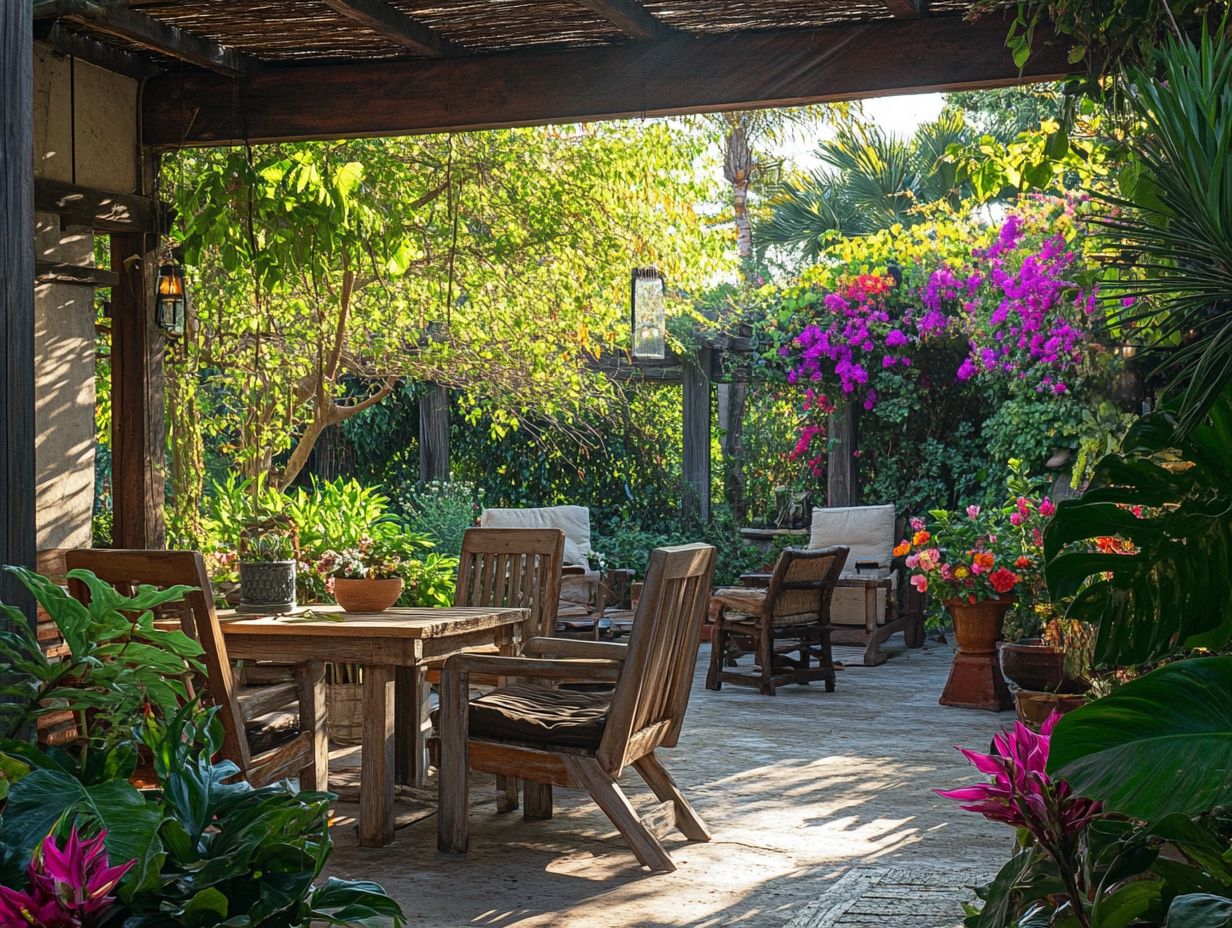
What are the top trends in outdoor decor for eco-conscious homeowners?
The top trends in outdoor decor for eco-conscious homeowners include using sustainable materials, incorporating native plants, utilizing solar-powered lighting, creating natural water features, and setting up systems to collect rainwater.
How can I use sustainable materials in my outdoor decor?
You can use sustainable materials such as bamboo, reclaimed wood, and recycled plastics in your outdoor decor. These materials are environmentally friendly and often durable, making them a great choice for outdoor use.
Why is incorporating native plants important for eco-conscious homeowners?
Incorporating native plants supports local ecosystems and reduces the need for excessive watering and maintenance. Native plants are more resilient to local weather and pests, making them a more sustainable choice.
What are the benefits of using solar-powered lighting in my outdoor decor?
Solar-powered lighting is a great way to reduce your energy consumption and carbon footprint. It also eliminates the need for wiring and electricity, making it a safer and more convenient option for outdoor spaces.
How can I create a natural water feature in my outdoor decor?
You can create a natural water feature by incorporating a rain garden, installing a rain barrel or cistern, or building a small pond or stream. These features not only add visual interest but also help conserve water and support local wildlife.
Why should I implement a rainwater harvesting system in my outdoor decor?
A rainwater harvesting system allows you to collect and store rainwater for later use in watering your plants or cleaning outdoor spaces. This reduces the strain on municipal water supplies and can also save you money on your water bill.
Start your eco-friendly journey today by making smart choices! Dive into our resources to transform your outdoor space into an eco-paradise!




